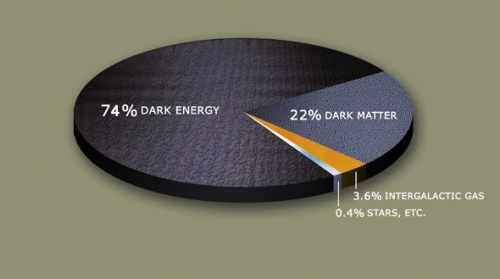Dark Energy
In physical cosmology, Dark Energy is a hypothetical exotic form of energy that permeates all of space and tends to increase the rate of expansion of the universe. Dark energy is the most popular way to explain recent observations that the universe appears to be expanding at an accelerating rate. In the standard model of cosmology, dark energy currently accounts for 74% of the total mass-energy of the universe.
Two proposed forms for dark energy are the cosmological constant, a constant energy density filling space homogeneously, and scalar fields such as quintessence or moduli, dynamic quantities whose energy density can vary in time and space. Contributions from scalar fields that are constant in space are usually also included in the cosmological constant. The cosmological constant is physically equivalent to vacuum energy. Scalar fields which do change in space can be difficult to distinguish from a cosmological constant because the change may be extremely slow.
High-precision measurements of the expansion of the universe are required to understand how the expansion rate changes over time. In general relativity, the evolution of the expansion rate is parameterized by the cosmological equation of state. Measuring the equation of state of dark energy is one of the biggest efforts in observational cosmology today.
Adding the cosmological constant to cosmology's standard FLRW metric leads to the Lambda-CDM model, which has been referred to as the "standard model" of cosmology because of its precise agreement with observations. Dark energy has been used as a crucial ingredient in a recent attempt to formulate a cyclic model for the universe.
Evidence for Dark Energy[edit]
Supernovae[edit]
In 1998, observations of Type Ia supernovae ("one-A") by the Supernova Cosmology Project at the Lawrence Berkeley National Laboratory and the High-z Supernova Search Team suggested that the expansion of the universe is accelerating. Since then, these observations have been corroborated by several independent sources. Measurements of the cosmic microwave background, gravitational lensing, and the large scale structure of the cosmos as well as improved measurements of supernovae have been consistent with the Lambda-CDM model.
Supernovae are useful for cosmology because they are excellent standard candles across cosmological distances. They allow the expansion history of the Universe to be measured by looking at the relationship between the distance to an object and its redshift, which gives how fast it is receding from us. The relationship is roughly linear, according to Hubble's law. It is relatively easy to measure redshift, but finding the distance to an object is more difficult. Usually, astronomers use standard candles: objects for which the intrinsic brightness, the absolute magnitude, is known. This allows the object's distance to be measured from its actually observed brightness, or apparent magnitude. Type Ia supernovae are the best-known standard candles across cosmological distances because of their extreme, and extremely consistent, brightness.
Cosmic Microwave Background[edit]
The existence of dark energy, in whatever form, is needed to reconcile the measured geometry of space with the total amount of matter in the universe. Measurements of cosmic microwave background (CMB) anisotropies, most recently by the WMAP satellite, indicate that the universe is very close to flat. For the shape of the universe to be flat, the mass/energy density of the universe must be equal to a certain critical density. The total amount of matter in the universe (including baryons and dark matter), as measured by the CMB, accounts for only about 30% of the critical density. This implies the existence of an additional form of energy to account for the remaining 70%. The most recent WMAP observations are consistent with a universe made up of 74% dark energy, 22% dark matter, and 4% ordinary matter.
Large-Scale Structure[edit]
The theory of large scale structure, which governs the formation of structure in the universe (stars, quasars, galaxies and galaxy clusters), also suggests that the density of baryonic matter in the universe is only 30% of the critical density.
Late-time Integrated Sachs-Wolfe Effect[edit]
Accelerated cosmic expansion causes gravitational potential wells and hills to flatten as photons pass through them, producing cold spots and hot spots on the CMB aligned with vast supervoids and superclusters. This so-called late-time Integrated Sachs-Wolfe effect (ISW) is a direct signal of dark energy in a flat universe, and has recently been detected at high significance by Ho et al. and Giannantonio et al. In May 2008, Granett, Neyrinck & Szapudi found arguably the clearest evidence yet for the ISW effect, imaging the average imprint of superclusters and supervoids on the CMB.
